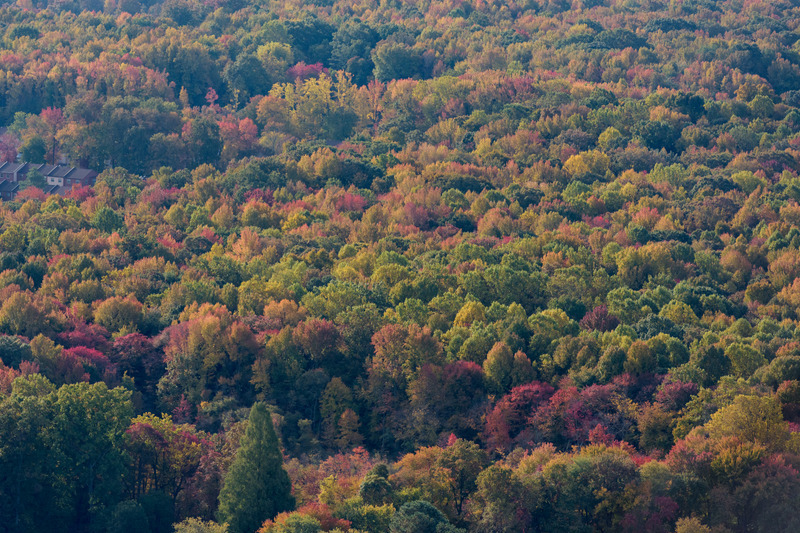


Carbon credit quality
Photo by Evan Krape May 20, 2025
New study evaluates the strength of protocols for forest carbon credits
The Earth’s vast network of forests absorbs more than 15 billion metric tonnes of carbon dioxide from the planet’s atmosphere each year.
Acting as natural carbon sinks, forests breathe in and out carbon dioxide through plant leaves via photosynthesis and respiration. As forests grow, they store carbon in tree trunks, branches, roots and soils, preventing that carbon from returning to the atmosphere and providing many climate benefits.
Enter forest carbon markets. These markets allow for buyers to purchase carbon credits that each represent one tonne of carbon stored in the forests instead of being released into the atmosphere.
Carbon credits for forests and land use make up nearly 40% of all carbon credits issued around the world. Forest carbon markets around the world have various protocols that set the rules and requirements governing the carbon credits.
“These credits are important for protecting the forest carbon sink,” said Rodrigo Vargas, a University of Delaware professor of ecosystem ecology and environmental change. “If we know that there is a certain amount of carbon stored in a place and we know that the amount of carbon has an economic value, then we can include a monetary value to that specific forest and the climate benefits that it brings.”
In a new review published in the journal Earth’s Future, Vargas is among a group of leading forest scientists around the U.S. arguing that forest carbon market protocols are flawed and don’t ensure that issued carbon credits accurately account for reduced and removed CO2 emissions. The researchers say a handful of improvements could boost the quality of forest carbon credits and drive up demand and confidence in the market. The study is the first of its kind to score forest carbon protocols. The paper, a report, and a scorecard of 20 forest carbon credit protocols were published on May 15.
Vargas joined a group of scientists from the Clean Air Task Force, Boston University, the University of New Mexico, University of Vermont, Yale University, several other universities, and the U.S. Forest Service to score 20 forest carbon protocols used in North American voluntary and compliance carbon markets. They reviewed protocols for improved forest management, planting trees on forested land or lands that could support forests, and avoided forest conversion — when projects try to prevent trees from being cleared so forest land can be used for farming or commercial development.
The researchers scored the protocols based on things like how long the protocols could monitor carbon for once the credit is issued, demonstrating that the carbon stored would be in the atmosphere without the carbon credit incentive, quantifying and monitoring requirements, and accounting for carbon leakage.
Of the 20 protocols, the majority were scored as “weak” or “very weak.” Only one protocol was deemed “satisfactory,” though the protocol had not issued any credits at the time the researchers evaluated it. The researchers say the review and scorecard highlight several issues.
The first challenge is permanence. The researchers argue that most protocols don’t adequately account for potential disruptions to carbon storage overtime, such as wildfires, pests and land use changes.
Second, the researchers argue there is a lack of additionality, the ability to show that the carbon stored in forests would have ended up in the atmosphere without the incentive of carbon credits.
Third, the researchers say quantification and monitoring requirements range from “very weak” to “robust,” and are needed to ensure that forest carbon credits are accurate and high quality — ensuring the climate benefits they say they have.
“Having high-quality credits is good for everybody,” Vargas said. “It’s good for the market, it’s good for insurance purposes, and it’s good for protecting natural resources and the environment. In that case, everyone who contributes to the market ideally will be happy and have the security that money is being invested for the right reason.”
Fourth, the researchers say many protocols don’t adequately account for the possibility that carbon could leak out and return to the atmosphere.
“The current protocols need to be strengthened to restore confidence in the market and ensure that forest carbon credits achieve their promised climate benefits,” Vargas said.
The group of scientists recommends improvements for forest carbon protocols to ensure they are high-quality in the future.
Their recommended improvements include requiring risk assessments at least every five years, deriving baselines from observations gathered over time, articulating and reporting uncertainty, and investing in research to better develop tools to understand carbon leakage.
“We need to revise the permanence risks,” Vargas said. “We need to understand that there are weak additionality rules. We need to recognize that at this moment, they are usually not checking for carbon leakages in these programs. And it’s important to address monitoring and verification gaps on that.”
Vargas and the researchers say that adopting their recommendations could result in fewer carbon credits being issued for each project while the price per carbon credit increases due to higher confidence in the data.
Contact Us
Have a UDaily story idea?
Contact us at ocm@udel.edu
Members of the press
Contact us at 302-831-NEWS or visit the Media Relations website

